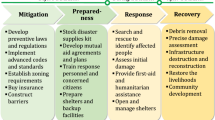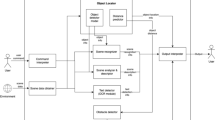Abstract
In Japan, for tsunami disaster prevention, the government prepares tsunami hazard maps and provides them to residents. However, residents often do not examine the provided maps. Thus, these maps are not well utilized. In this study, we focused on the offline Geographic Information System and proposed a tsunami disaster drill support system that displays a tsunami hazard map, the current location, and route for the users. Using a prototype of the proposed system, we conducted an evaluation for the same in the Otaru City, Hokkaido. The results showed that the basic functions of the proposed system were mostly favorable for the evacuation process.









Similar content being viewed by others
Data availability
The datasets of GPS log in Fig.8 generated during the current study are available in the TsunamiDisasterDrillSupportSystem, at GitHub (https://github.com/h-fukada-OUC/TsunamiDisasterDrillSupportSystem).
References
Disaster Management, Cabinet Office, Government of Japan (2017) The Great East Japan Earthquake, https://www.bousai.go.jp/kohou/kouhoubousai/h23/63/special_01.html. Accessed 20 March 2023
Katada T, Kanai M, Hosoi K, Kuwasawa N (2011) Issues of implementations to be intended for only applicants for Bousai seminar—according to seminar to guide how to evacuate from tsunamis. Proc JSCE, F5. 67:1–13 (In Japanese)
Katada T, Kimura S, Kodama M (2007) A study on flood hazard map for disaster risk communications. Proc JSCE, Div D 63:498–508 (In Japanese)
Mohan P, Mittal H (2020) Review of ICT usage in disaster management. Int J technol 12(3):955–962. https://doi.org/10.1007/s41870-020-00468-y
Han SY, Tsou MH, Knaap E, Rey S, Cao G (2019) How do cities flow in an emergency? Tracing human mobility patterns during a natural disaster with big data and geospatial data science. Urban Sci 3(2):51. https://doi.org/10.3390/urbansci3020051
Teshirogi Y, Sawamoto J, Segawa N, Sugino E (2009) A proposal of tsunami warning system using area mail disaster information service on mobile phones. Proc. International Workshop on Disaster and Emergency Information Network Systems, IEEE Computer Society. p 890–895.
Izuka K, Suzuki T, Ishikawa M, Izuka Y, Yoshida K (2011) Realtime disaster situation mapping system with functionality of estimating current location. IPSJ SIG Technical Report, Information System and Social Environment, (IS), 2011-IS-117. (2):1–8. (In Japanese)
Watanabe H, Narita Y, Oyama K, Kasezawa T, Takeuchi A, Takenaka T (2012) Development of disaster evacuation system for finding shortest routes with mobile devices. Inf Process Soc Jap 53:1768–1773 (In Japanese)
Mihara Y, Hirakawa R, Kawano H, Nakashi K, Nakatoh Y (2019) Study on evaluating risks of routes damages at Earthquakes for Evacua-tion Guidance System, Proc 7th Conf on Applied Computing and Information Technology (ACIT2019). 35:1–6. https://doi.org/10.1145/3325291.3325390
Kataoka T, Takishima K, Homma K, Kohiga A, Fukaya S, Hiroi K, Shinoda Y (2022) Development of smartphone app min-hina with a form of information representation that promotes evacuation behavior in the event of flooding. IPSJ SIG Technical Report, Consumer Devices and Systems, (CDS), 2022-CDS-34 (4):1–6. (In Japanese)
Hamamura A, Fukushima T, Yoshino T, Egusa N (2014) Evacuation support system for everyday use in the aftermath of a natural disaster, Proc 16th Conf on Human-Computer Interaction (HCII 2014). 8529:600–611
Yamori K, Sugiyama T (2020) Development and social implementation of smartphone app nige-tore for improving tsunami evacuation drills: synergistic effects between commitment and contingency. Int J Disas Risk Sci 11:751–761. https://doi.org/10.1007/s13753-020-00319-1
Kawai J, Mitsuhara H, Shishibori M (2015) Tsunami evacuation drill system using smart glasses. Proc Comp Sci 72:329–336. https://doi.org/10.1016/j.procs.2015.12.147
Mitsuhara H, Shishibori M (2022) Tsunami evacuation drill system focusing on mobile devices. Int J Interact Mob Technol 16(6):4–20. https://doi.org/10.3991/ijim.v16i06.23419
Asami K, Kobayashi D, Nojima N, Ichihara K, Sakurai M, Yamamoto S (2011) Evaluation of evacuation behavior based on an evacuation behavior model using personal digital assistant. Proc 13th Conf Jap Soc for Disas Info Studies. p 351–356.
Fukuda H, Hashimoto Y, Akabuchi A, Oki M, Okuno Y (2013) Proposal of tsunami evacuation support system using a tablet computer, papers from multimedia, distributed, cooperative, and mobile (DICOMO2013) symposium. IPSJ Symposium Series 2013:1938–1944 (In Japanese)
TapGIS (2017) http://www.hunes.co.jp/hnshome/products/products_tapgis.html. Accessed 20 March 2023
Fukada H, Hashimoto Y, Akabuchi A, Oki M, Okuno Y (2013) Evaluation of tsunami refuge support system using mobile gis with offline capability—taking otaru city, hokkaido as the experimental field. Papers Proc Geogr Inf Syst Assoc 22:1–4 (In Japanese)
Fukada H (2023) TsunamiDisasterDrillSupportSystem. https://github.com/h-fukada-OUC/TsunamiDisasterDrillSupportSystem. Accessed 7 Aug 2023
Nakagawa K, Suda T, Zempo H, Matsumoto K (2001) The development of questionnaire for evaluating web usability. The 10th Human Interface Society Bulletin. p 421–424. (In Japanese)
Acknowledgements
We would like to extend our most sincere appreciation to citizens of Otaru city who participated in the usability evaluation using the prototype of the proposed system.
Funding
This work was supported by Japan Society for the Promotion of Science (JSPS) Grants-in-Aid for Scientific Research, KAKENHI Grant Numbers JP24520883, JP20K12394, JP22K01040, and JP23K00969.
Author information
Authors and Affiliations
Corresponding author
Ethics declarations
Conflict of interest
This study received technical support from the head of the system development department at Hunes Corporation, Japan. The authors of this paper are paying honorarium to the company for their technical support.
Rights and permissions
Springer Nature or its licensor (e.g. a society or other partner) holds exclusive rights to this article under a publishing agreement with the author(s) or other rightsholder(s); author self-archiving of the accepted manuscript version of this article is solely governed by the terms of such publishing agreement and applicable law.
About this article
Cite this article
Fukada, H., Hashimoto, Y., Oki, M. et al. Proposal and evaluation of tsunami disaster drill support system using tablet computer. Int. j. inf. tecnol. 15, 4029–4039 (2023). https://doi.org/10.1007/s41870-023-01465-7
Received:
Accepted:
Published:
Issue Date:
DOI: https://doi.org/10.1007/s41870-023-01465-7




